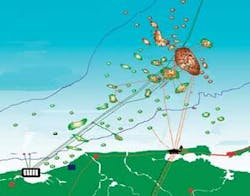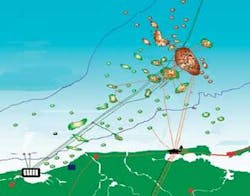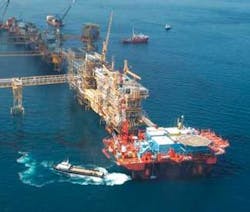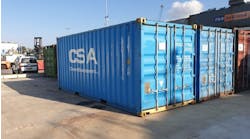Despite falling output, Mexican politics keep foreign operators out
David Shields, Mexico Correspondent
Time - and oil - are running out for state oil company Petroleos Mexicanos (Pemex). The supergiant Cantarell field, which boasts the highest offshore crude oil production in the world, is seeing what could be a steep decline, hitting Mexico’s crude oil production and exports in the short-term. Output from Cantarell - which provides over half of Mexico’s total production - declined by 199,000 b/d, or 10.3%, in the first half of 2006, ending the semester with an output level of 1,739,000 b/d.
The Cantarell field, with Mexico’s highest production rate, is seeing an output decline.
Pemex appears to have few options to offset falling output in the near-term. The two best options may be the Ku-Zaap-Maloob complex and the Light Crude Oil Project, both of which, like Cantarell, are in the Bay of Campeche in southeastern Mexico. It seems unlikely, however, that either project could provide enough crude to compensate for lost output from Cantarell in the medium-term.
As a result, Pemex executives have been promoting Mexican deepwater as the major long-term offshore alternative to the declining shallow-water plays in Campeche Bay. The company has been doing 2D and 3D seismic studies in deepwater for several years now and drilled several exploratory wells. The Vicente Fox administration is pushing for the industry to be opened to international companies, probably through some kind of joint ventures with Pemex, or possibly through concessions or profit-sharing agreements.
However, Mexico’s nationalistic and ever more turbulent politics continues to prevent reforms that would open the industry to direct foreign investment in E&P or even allow Pemex a greater investment budget. The country has been roiled in a nasty and inconclusive presidential election in recent months, which divided the nation as the two leading candidates, with greatly differing ideological stances, ended up in a dead-heat.
In recent years, it has been impossible to achieve consensus on any kind of energy reforms in Mexico’s congress, a situation which might well continue. However, if the pro-reform candidate, Felipe Calderon, the apparent winner of the election by a hair’s breadth, is sworn in as president in December, he may find more support from congress than President Vicente Fox has had over the past six years. Also, the depletion rate on Cantarell may jolt the political system into undertaking oil industry reforms next year.
Pemex’s exploration efforts have been mostly unsuccessful and were hindered by insufficient funding during the past decade, as the company has devoted most of its E&P budget to production. The company has replaced scarcely 10% of oil produced in recent years with new proven reserves. Mexico’s proven crude oil reserves currently stand at 11.9 Bbbl.
Eduardo Sojo, who heads Calderon’s economic team, says an increase in the replacement rate is needed urgently. “We are practically exhausting our reserves. We will have to send a bill to congress allowing Pemex to enter into joint ventures with the private sector,” he says.
Cantarell decline accelerates
In the first half of 2006, crude oil output from Cantarell fell from 1,938,000 b/d in December to 1,739,000 b/d in June, according to the Energy Ministry. The decline was steeper than expected. Output dropped by 64,000 b/d in June alone. Mexico’s total June crude oil production was 3,287,000 b/d, down 3% over the semester and year on year.
Although Cantarell is performing below expectations, Pemex executives said in August that decline from the field is “temporary”, as remedial action is being taken, and that Mexico’s total oil output for this year will average close to 3,350,000 b/d. They are sticking to their December 2005 forecast that Cantarell will produce 1,683,000 b/d in 2007, even though some Pemex engineers have been quoted publicly as saying Cantarell output could drop as low as 875,000 b/d by the end of 2007 and 520,000 b/d at year-end 2008.
Mexican crude oil output peaked in October 2004 at 3,451,349 b/d, with Cantarell peaking in the same month at 2,132,018 b/d. Nevertheless, Pemex still plans to drill another 61 development wells in Cantarell over the next decade. Until recently, 216 wells were operating on the field, though 33 wells have been shut in recently.
Ku-Maloob-Zaap on the rise
Pemex says output from other fields will offset much of the decline from Cantarell. Two offshore projects, known as Ku-Maloob-Zaap (KMZ) and Offshore Light Crude, seem to be the best short-term prospects. Only KMZ is considered to have major upside potential.
KMZ is a group of hydraulically interconnected offshore fields in Campeche Bay, close to Cantarell and 62 mi (105 km) from the coast. Output from KMZ stood at 415,000 b/d in June 2005, up from 300,000 b/d less than two years ago. Pemex says output from KMZ will reach 800,000 b/d before the end of the decade, with the company planning to spend $5.7 billion on 97 development wells on KMZ over the next few years. Some Pemex engineers, however, say they believe that output goal to be overly optimistic.
At year end, Pemex expects to take delivery of a $700 million FPSO that will anchor in Campeche Bay and mix crude types to upgrade extra-heavy crude being produced from the KMZ fields. Crude from KMZ is mainly 13 API, though there is some crude of between 22 and 24 API. This output will be mixed, along with some Cantarell crude, aboard the FPSO to obtain 21 API Maya oil, which will then be offloaded to tankers for export, thus allowing Pemex to maintain the quality of crude it provides to export. The FPSO is being built by Bergesen at shipyards in Norway and Singapore.
Deepwater efforts
As many of its shallow-water fields decline, Pemex executives tout Mexican GoM deepwater areas as the new frontier of the industry and speak of major long-term potential of about 30 Bbbl thought to be in these areas. They also talk of drilling 151 exploratory wells in deepwater over the next decade. Pemex, however, just drilled its first few deepwater wells, contracted to Diamond Offshore, and no commercial discoveries were reported.
Pemex’s E&P division planning director, Vinicio Suro, made a presentation to companies at a private meeting in Houston in July at which he invited them to work with Pemex both in technology development and in deepwater drilling. Attendees said, however, that only service contracts for drilling are offered by Pemex due to Mexico’s restrictive legal framework.
Pemex executives say Mexico’s ideal scenario would be to achieve constitutional and legal amendments to allow international companies to get concessions, or production-sharing and profit-sharing contracts for deepwater work. However, such changes are politically restricted at this time.
Near-term drilling work is aimed mainly at the Coatzacoalcos deepwater area in southeastern Mexico, where Diamond Offshore recently drilled the Noxal-1 well in 951 m (3,115 ft) of water. President Vicente Fox and Pemex executives hyped this area saying it could contain as much as 10 Bbbl of unproven oil reserves. Pemex tentatively talked to at least eight oil majors about getting technological support for its deepwater work.
Oil majors would like to reach some kind of joint venture deal with Pemex on E&P issues, particularly related to deepwater, but would want contracts allowing for risk and reward balance. As noted, those contracts are off limits legally at this point.
However, several majors are looking at possible technology-sharing agreements and at helping Pemex finance future projects, until such time as reforms may be made. Recently, Pemex has been emphatic about working within the current legal framework in order to avoid the kind of legal controversy that has hampered its attempts at opening E&P work onshore in nonassociated gas-producing areas. Company executives hope to reach commitments on cooperation with oil majors that would bind Mexico’s next federal administration, which takes office next December.
Unitization agreement discussed
Another deepwater area of great interest to both Mexico and the US is the Perdido Fold Belt. It straddles the two countries’ maritime boundary. Mexican officials say they will seek a unitization agreement with the US for E&P work on shared deepwater fields in the Gulf.
They would work jointly with the US towards an agreement to allow drilling on the Mexican side of cross-border fields. The Mexican government created an intersecretarial commission, in which Pemex, the Energy Ministry, the Finance Ministry, and the Foreign Affairs Ministry work together on future coordination with the US on this issue.
Production facilities in Cantarell.
Pemex also says it is working on a contract model to allow joint ventures with international companies to develop these cross-border fields. The contract model has been evaluated by the Energy and Finance ministries and could be implemented if the political environment were to improve, assuming Mexico’s congress were to take up the issue of cross-border fields as part of its agenda.
However, under the current constitutional framework, Pemex cannot take part in the joint ventures it would need in order to gain experience in producing at water depths of about 2,100 m (7,000 ft) such as in the Perdido Fold Belt. International oil majors told Pemex they are not interested in service contracts for work at such depths.
Pemex E&P chief Carlos Morales says it might be possible to sign a unitization agreement allowing for joint exploitation by the two nations without making changes to Mexico’s constitution. Amendments to enabling laws might be sufficient to allow joint ventures for cross-border fields, he says.
Pemex executives also suggest that deepwater drilling on the US side of the maritime boundary may put at risk as much as 2.6 Bbbl of oil reserves on the Mexican side. This is based on the theory that oil could migrate from the Mexican side to production wells on the US side. Concern appears to relate to the Great White field, which extends largely into Mexican waters, though such declarations by Pemex may be little more than propagandistic efforts by officials pushing for reform.
Deepwater exploration
Pemex contracted three exploratory wells, Nab-1, Caxui-1, and Noxal-1 in southeast Mexico, to Diamond Offshore’sOcean Worker. Heavy 9 API oil was discovered at Nab-1, not far from the Cantarell complex in Campeche Bay at 689-m (2,256-ft) water depth in late 2004. It was a non-commercial find of extra-heavy oil, and chemicals had to be injected into the well to make it flow. However, it confirmed the extension of the alignment of the Cantarell and KMZ oil fields towards the northwest.
The second well, Caxui-1, in 670 m (2,195 ft) of water, was completed in October 2005. It was a stratigraphic test well aimed at getting geological information in the central area of a region known as the Mexican Ridges.
Noxal-1, farther east in the Coatzacoalcos Deepwater area, discovered a small amount of gas 2,137 m (6,998 ft) below sea level. Though non-commercial, Pemex says the discovery is important in confirming that the area has oil and gas potential, and that it provided information allowing short-term planning for further exploratory drilling. Pemex intends to drill four more wells, Lacach-1, Leek-1, Hixcai-1, and Chelem-1, in the same area at water depths of close to 1,000 m (3,275 ft). However, there is a question of rig availability.
According to E&P Chief Morales, Pemex may have to wait for a rig to come available to continue with its deepwater plans. Moreover, day rates for semisubmersibles have more than doubled in recent times, ranging from $50,000 - $70,000 at the beginning of 2005, to $150,000 - $300,000 as a result of increased rig demand worldwide. Diamond Offshore, which drilled the three aforementioned wells at a day rate averaging $67,500, says the market rate for its semis is $160,000 or more.
Diamond Offshore has four semis (Ocean Ambassador, Ocean Whittington, Ocean Yorktown, and Ocean Nugget) on contract to Pemex, but for shallow waters, not the 1,000 m (3,000 ft) waters of the Coatzacoalcos.
International drilling companies currently have 42 offshore rigs on contract to Pemex. Contracts for 13 of these rigs expire around October 2007. Rig prices, however, are not expected to drop until 2009 when rigs currently under construction come into the market. Companies with the most Pemex drilling contracts are Pride International, Noble Drilling, Nabors Offshore, Todco, and Diamond Offshore.
Producing oil in deepwater clearly implies much greater costs for Pemex than work on Cantarell and other fields in the shallow-water Campeche Bay area. Pemex estimates average production costs are likely to be in the $11 to $12 range in virgin offshore areas, as compared to $4.34 in Cantarell.
Though a modest cut on total taxes paid by Pemex was approved by Congress at end-2005, the company still has a tax burden which siphons about 80% of its total revenues. Under current tax conditions, E&P projects are not viable when production costs exceed $6.50/bbl, say finance officials at Pemex. So, major fiscal reforms will be needed soon for Pemex to keep operating and to pay off its hefty debts, regardless of any other legal amendments to allow direct foreign investment.





